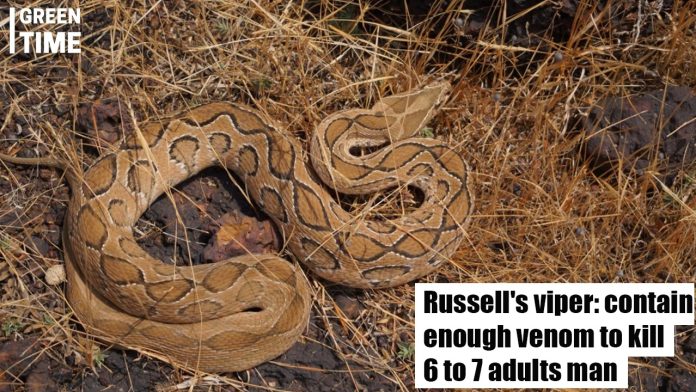The Russell’s viper is a highly perilous snake found in Asia, responsible for causing numerous fatalities annually. After being bitten, individuals may encounter a diverse range of symptoms such as pain, swelling, vomiting, disorientation, inability of blood to coagulate, and kidney failure. In order to enhance our comprehension of the lethal impact of the venom and optimize treatment for envenomed individuals, we will examine the venom’s influence on the blood coagulation process and renal function.
How do we recognize this snake?
It has similarities to a juvenile python, including a concise and slim tail, and generally has a length ranging from three to five feet. The snake possesses a flat and triangular head that is clearly separate from its neck. The head is embellished with dark brown irregular dots resembling moons, which are distributed throughout its body. These characteristics allow it to blend in effortlessly with dry foliage or rice fields.
Contrary to the majority of snakes, which reproduce by laying eggs, the Russell’s viper gives birth to live offspring. A female viper typically gives birth to a litter of 20 to 40 cubs, although there have been documented cases of up to 80 offspring. Their rapid population growth is facilitated by their high reproductive rate, as well as the ample availability of prey such as mice and frogs in agriculture fields.
Affected Area
The Russell’s viper has proliferated in the districts of Rajshahi, Natore, Naogaon, Chapainawabganj, Pabna, Jaipurhat, Jhenaidah, Meherpur, Kushtia, Jashore, Satkhira, Chuadanga, Rajbari, Faridpur, Madaripur, Shariatpur, Manikganj, Munshiganj, Dhaka, Chandpur, Laxmipur, Noakhali, Barisal, Patuakhali, Bhola, Barguna, and Jhalakathi.
Steps To Avoid Russel’s Viper Attack?
Russell’s vipers are known for their aggressive behaviour. While most snakes avoid human contact, Russell’s vipers will strike if they feel threatened.
When disturbed, they strike with amazing speed, completing the entire process in less than a sixteenth of a second and producing a loud hissing sound comparable to a pressure cooker. The venom of the Russell’s viper is hematotoxic, inflicting significant tissue damage. A bite causes acute swelling and can destroy several organs, including the lungs and kidneys. Without immediate medical attention, the injured area may begin to decay within five minutes of the bite. The Russell’s viper, which was originally native to the Barendra region, is now found in at least 25 districts across the country. Significant populations may be found in the Padma, Meghna, and Jamuna river basins, which include Manikganj, Faridpur, and Shariatpur.

This trend has resulted in an upsurge in snakebite incidence, particularly among farmers and fishermen who operate in fields without proper safety equipment. To maximize protection against snake bites, it is advisable to wear knee-high boots crafted from durable leather or other materials that are resistant to punctures. Additionally, it is recommended to tuck long jeans into the boots. To enhance safety, it is advisable to utilize snake chaps as a means of safeguarding your legs.
What to do after being bitten by a Russell’s viper?
It is not advisable to attempt self-treatment for a bite from a Russell’s viper. Contact emergency services or promptly transport the injured individual to the nearest hospital. Here are some instructions to follow while waiting for medical assistance:
- Maintain composure and provide reassurance to the individual in distress.
- If feasible, ascertain the species of the snake, but priorities seeking assistance over the act of identification. This information will be beneficial for healthcare practitioners in accurately giving the appropriate treatment.
- Take off any constricting garments or accessories from the affected limb.
Secure the bitten limb with a splint and maintain it at a position lower than the heart. - Place a tight bandage (avoid using a tourniquet) directly on the area where the bite occurred.

